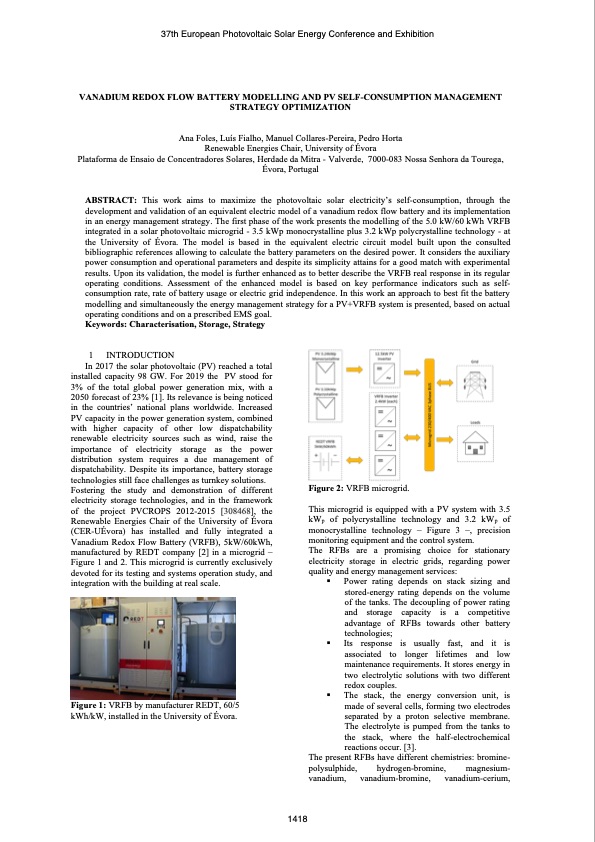
PDF Publication Title:
Text from PDF Page: 001
37th European Photovoltaic Solar Energy Conference and Exhibition VANADIUM REDOX FLOW BATTERY MODELLING AND PV SELF-CONSUMPTION MANAGEMENT STRATEGY OPTIMIZATION Ana Foles, Luís Fialho, Manuel Collares-Pereira, Pedro Horta Renewable Energies Chair, University of Évora ABSTRACT: This work aims to maximize the photovoltaic solar electricity’s self-consumption, through the development and validation of an equivalent electric model of a vanadium redox flow battery and its implementation in an energy management strategy. The first phase of the work presents the modelling of the 5.0 kW/60 kWh VRFB integrated in a solar photovoltaic microgrid - 3.5 kWp monocrystalline plus 3.2 kWp polycrystalline technology - at the University of Évora. The model is based in the equivalent electric circuit model built upon the consulted bibliographic references allowing to calculate the battery parameters on the desired power. It considers the auxiliary power consumption and operational parameters and despite its simplicity attains for a good match with experimental results. Upon its validation, the model is further enhanced as to better describe the VRFB real response in its regular operating conditions. Assessment of the enhanced model is based on key performance indicators such as self- consumption rate, rate of battery usage or electric grid independence. In this work an approach to best fit the battery modelling and simultaneously the energy management strategy for a PV+VRFB system is presented, based on actual operating conditions and on a prescribed EMS goal. Plataforma de Ensaio de Concentradores Solares, Herdade da Mitra - Valverde, 7000-083 Nossa Senhora da Tourega, Évora, Portugal Keywords: Characterisation, Storage, Strategy 1 INTRODUCTION In 2017 the solar photovoltaic (PV) reached a total installed capacity 98 GW. For 2019 the PV stood for 3% of the total global power generation mix, with a 2050 forecast of 23% [1]. Its relevance is being noticed in the countries’ national plans worldwide. Increased PV capacity in the power generation system, combined with higher capacity of other low dispatchability renewable electricity sources such as wind, raise the importance of electricity storage as the power distribution system requires a due management of dispatchability. Despite its importance, battery storage technologies still face challenges as turnkey solutions. Fostering the study and demonstration of different electricity storage technologies, and in the framework of the project PVCROPS 2012-2015 [308468], the Renewable Energies Chair of the University of Évora (CER-UÉvora) has installed and fully integrated a Vanadium Redox Flow Battery (VRFB), 5kW/60kWh, manufactured by REDT company [2] in a microgrid – Figure 1 and 2. This microgrid is currently exclusively devoted for its testing and systems operation study, and integration with the building at real scale. Figure 1: VRFB by manufacturer REDT, 60/5 kWh/kW, installed in the University of Évora. Figure 2: VRFB microgrid. This microgrid is equipped with a PV system with 3.5 kWp of polycrystalline technology and 3.2 kWp of monocrystalline technology – Figure 3 –, precision monitoring equipment and the control system. The RFBs are a promising choice for stationary electricity storage in electric grids, regarding power quality and energy management services: ▪ Power rating depends on stack sizing and stored-energy rating depends on the volume of the tanks. The decoupling of power rating and storage capacity is a competitive advantage of RFBs towards other battery technologies; ▪ Its response is usually fast, and it is associated to longer lifetimes and low maintenance requirements. It stores energy in two electrolytic solutions with two different redox couples. ▪ The stack, the energy conversion unit, is made of several cells, forming two electrodes separated by a proton selective membrane. The electrolyte is pumped from the tanks to the stack, where the half-electrochemical reactions occur. [3]. The present RFBs have different chemistries: bromine- polysulphide, hydrogen-bromine, magnesium- vanadium, vanadium-bromine, vanadium-cerium, 1418PDF Image | VANADIUM REDOX FLOW BATTERY MODELLING

PDF Search Title:
VANADIUM REDOX FLOW BATTERY MODELLINGOriginal File Name Searched:
Vanadium-Redox-Flow-Battery-Modelling.pdfDIY PDF Search: Google It | Yahoo | Bing
Salgenx Redox Flow Battery Technology: Salt water flow battery technology with low cost and great energy density that can be used for power storage and thermal storage. Let us de-risk your production using our license. Our aqueous flow battery is less cost than Tesla Megapack and available faster. Redox flow battery. No membrane needed like with Vanadium, or Bromine. Salgenx flow battery
| CONTACT TEL: 608-238-6001 Email: greg@salgenx.com | RSS | AMP |